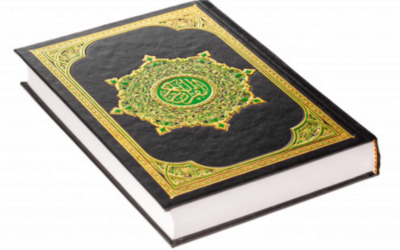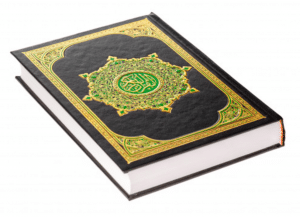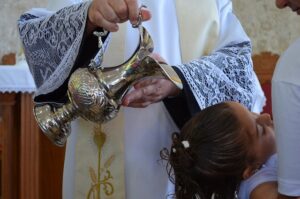The so-called “Book of Abraham” is a part of the LDS Scripures in a collection known as the “Pearl of Great Price.” It provides us with an important test case on whether or not Joseph Smith, the founder of the Mormon religion, is a true prophet of God. Not surprisingly, it demonstrates that he is not.
The Signifigance of the Topic
There are many proofs that Joseph Smith was a false prophet, but Mormons typically will not accept them. From the biblical evidence that contradicts Mormon theology to the contradictions within its own history and doctrine, proofs abound. But Mormons, completely dedicated to their religion and their testimony, cannot and will not see the evidence. They rely not on biblical evidence–not on historical evidence but rather trust a ‘testimony’ that Mormonism is the restored church and Joseph Smith its true prophet.
One of the tests of whether or not a belief is grounded in reality is whether or not it can be proven to be true or false. If someone says, “I don’t care what evidence you show me, I will always believe,” then that person’s faith is not rooted in reality. And since Christianity is a religion of history, crucifixion, resurrection, an empty tomb, etc., it is a religion rooted in reality. If it could be proven beyond doubt that Jesus did not rise from the dead, then Christianity is a false religion. Likewise, if it could be proven that Joseph Smith was a false prophet, then Mormonism is a false religion. It just so happens that there is such a proof.
A Brief History of the The Book of Abraham
Joseph Smith claimed that an angel appeared to him and revealed the location of some golden plates on which was written the account of the ancient people of the Americas. Joseph Smith later translated those plates into what is now known as the Book of Mormon. This translation was done by the power of God through special means. Joseph Smith, being the Lord’s chosen instrument, became the prophet of the Mormon church and held the office of Seer. A Seer, according to the Book of Mormon in Mosiah 8:13, can translate records that are untranslatable. Hence, Joseph Smith was able to translate the golden plates into the Book of Mormon. But his Seer abilities did not stop there.
In July of 1835, an Irishman named Michael Chandler brought an exhibit of four Egyptian mummies and papyri to Kirtland, Ohio–then the home of the Mormons. The papyri contained Egyptian hieroglyphs. However, in 1835 the understanding of the ancient Egyptian hieroglyphic language was still at an early stage of decipherment and was virtually unknown outside specialised academic circles in Europe.
As Prophet and Seer of the Church, Joseph Smith was given permission to look at the papyri scrolls in the exhibit and to everyone’s shock, revealed that “one of the rolls contained the writings of Abraham, another the writings of Joseph of Egypt.”1 The Church bought the exhibit for $2400. Joseph finished the translation of the Book of Abraham sometime later, but the book of Joseph was never translated. The papyri were lost soon afterwards and thought to have been destroyed in a fire in Chicago in 1871. There was, therefore, no way to validate Joseph’s translation. If the papyri were re-discovered and translated, it would either prove or disprove the abilities of Joseph as a prophet of God. After all, he was supposed to be a prophet and have the abilities of a Seer as the Book of Mormon and the Book of Abraham supposedly proved.
In October of 1880, The Pearl of Great Price, a collection of writings, which contained the book of Abraham, was recognized as scripture by the Mormon Church.
The “Book of Abraham” Papyri are Found
To everyone’s surprise, in 1966 the papyri were rediscovered in one of the vault rooms of the New York’s Metropolitan Museum of Art. The Deseret News of Salt Lake City on Nov. 27, 1967, acknowledged the rediscovery of the papyri. On the back of the papyri were “drawings of a temple and maps of the Kirtland, Ohio area.”2 There could be no doubt that this was the original document from which Joseph Smith translated the book of Abraham.
With the papyri rediscovered and Egyptian hieroglyphs decipherable since the late 1800’s, it would then be an easy task of translating the papyri and proving once and for all that Joseph Smith was a prophet with the gift of “Seer” as he and the Mormon church have claimed. This would then prove the truth of the Book of Mormon and the Book of Abraham and would vindicate Joseph Smith as a true prophet of God.
What do the Experts say about the Book of Abraham?
Joseph Smith copied three drawings from the Egyptian scrolls, labeled them Facsimile No. 1, No. 2, and No. 3 and incorporated them into the Book of Abraham with explanations of what they were. Egyptologists have viewed the drawings and found Joseph Smith’s interpretation of them to be wrong. But, the Mormons, in defense of the sacred book, maintained that the Facsimiles alone were not sufficient to prove that Joseph Smith was erring in his translating abilities. With the rediscovery of the papyri, not only were there the same drawings in the scrolls but also so was the text from which Joseph Smith made his translation. It was now possible to absolutely determine the accuracy of Smith’s translating abilities.
Facsimile No. 1
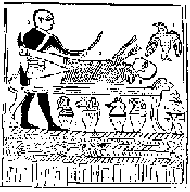 Joseph Smith said that Facsimile No. 1 was of a bird as the “Angel of the Lord” with “Abraham fastened upon an altar,” “being offered up as a sacrifice by a false priest. The pots under the altar were various gods “Elkenah, Libnah, Mahmackrah, Korash, Pharaoh,” etc.
Joseph Smith said that Facsimile No. 1 was of a bird as the “Angel of the Lord” with “Abraham fastened upon an altar,” “being offered up as a sacrifice by a false priest. The pots under the altar were various gods “Elkenah, Libnah, Mahmackrah, Korash, Pharaoh,” etc.
In reality, this is “an embalming scene showing the deceased lying on a lion-couch.”3
In the original papyri, this drawing is attached to hieroglyphs (See figure A) from which Joseph derived the beginning of the book of Abraham which begins with the words, “In the Land of the Chaldeans, at the residence of my father, I, Abraham, saw that it was needful for me to obtain another place of residence”(1:1). In reality, the hieroglyphs translate as, “Osiris shall be conveyed into the Great Pool of Khons–and likewise Osiris Hor, justified, born to Tikhebyt, justified — after his arms have been placed on his heart and the Breathing permit (which [Isis] made and has writing on its inside and outside) has been wrapped in royal linen and placed under his left arm near his heart; the rest of the mummy-bandages should be wrapped over it. The man for whom this book was copied will breath forever and ever as the bas of the gods do.”4
“It is the opening portion of an Egyptian Shait en Sensen, or Book of Breathings . . . a late funerary text that grew out of the earlier and more complex Book of the Dead.” “This particular scroll was prepared (as determined by handwriting, spelling, content, etc.) sometime during the late Ptolemaic or early Roman period (circa 50 B.C. to A.D. 50).”5
Figure A
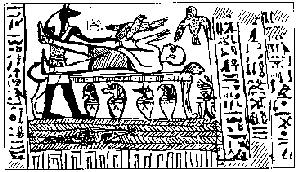 Figure A is a professional reconstruction of the original (Figure B). Note the hieroglyphs on the right side from which Joseph Smith began his translation of the Book of Abraham.
Figure A is a professional reconstruction of the original (Figure B). Note the hieroglyphs on the right side from which Joseph Smith began his translation of the Book of Abraham.
In actuality, it “depicts the mythical embalming and resurrection of Osiris, Egyptian god of the underworld. Osiris was slain by his jealous brother Set, who cut up his body into 16 pieces and scattered them . . . The jackal-headed god Anubis is shown embalming the body of Osiris on the traditional lion-headed couch so that he might come back to life . . . “6
Figure B
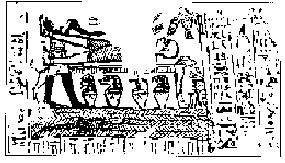
Figure B (to the right) shows a reprint of the actual papyrus used by Joseph Smith. Note the areas where the Papyrus has been lost. It is in these that Joseph Smith “finished” the drawing resulting in Facsimile No. 1. His restoration, according to Egyptologists, reveals a complete lack of understanding of Egyptian practice and theology.
Facsimile No. 2
 As is explained by Joseph Smith and included in the Pearl of Great Price, the second drawing contains different scenes which Joseph Smith interpreted. They vary: “Kolob, signifying the first creation, nearest to the celestial, or the residence of God.” “Stands next to Kolob, called by the Egyptians Oliblish, which is the next grand governing creation near to the celestial or the place where God resides.” “God, sitting upon his throne, clothed with power and authority.” ” . . . this is one of the governing planets also, and is said by the Egyptians to be the Sun, and to borrow its light from Kolob through the medium of Kae-e-vanrash, which is the grand Key . . . ”
As is explained by Joseph Smith and included in the Pearl of Great Price, the second drawing contains different scenes which Joseph Smith interpreted. They vary: “Kolob, signifying the first creation, nearest to the celestial, or the residence of God.” “Stands next to Kolob, called by the Egyptians Oliblish, which is the next grand governing creation near to the celestial or the place where God resides.” “God, sitting upon his throne, clothed with power and authority.” ” . . . this is one of the governing planets also, and is said by the Egyptians to be the Sun, and to borrow its light from Kolob through the medium of Kae-e-vanrash, which is the grand Key . . . ”
But again scholarship disagrees with Joseph’s rendition. “It is actually a rather common funerary amulet termed a hypocephalus, so-called because it was placed under (hypo) a mummy’s head (cephalus). Its purpose was to magically keep the deceased warm and to protect the body from desecration by grave robbers.”7
Facsimile No. 3
 According to Smith, this drawing shows “Abraham sitting upon Pharaoh’s throne, by the politeness of the king, with a crown upon his head, representing the Priesthood . . . King Pharaoh, whose name is given in the characters above his head . . . Signifies Abraham in Egypt . . . Olimlah, a slave belonging to the prince . . . ”
According to Smith, this drawing shows “Abraham sitting upon Pharaoh’s throne, by the politeness of the king, with a crown upon his head, representing the Priesthood . . . King Pharaoh, whose name is given in the characters above his head . . . Signifies Abraham in Egypt . . . Olimlah, a slave belonging to the prince . . . ”
But this is not what the Egyptologists say is the meaning of Facsimile No. 3. Instead, it shows “the deceased being led before Osiris, god of the dead, and behind the enthroned Osiris stands his wife Isis.”8
Conclusion
It should be quite obvious that present scholarship has revealed that Joseph Smith did not translate the Book of Abraham by the power of God as he had claimed. It follows that if he did not translate the Book of Abraham by the power of God, then it would be very easy to conclude that he did not translate the Book of Mormon by the power of God either.
When Joseph first gave his translation, hieroglyphs were undecipherable. Today they are. He was safe in saying anything he wanted to, and there would be no way of proving him wrong. But with the resurfacing of the same papyri he used to do his Book of Abraham translation and the fact that he did not in any way do it correctly should be proof enough that Joseph Smith lied about his abilities from God. He has been shown to be a false prophet.
For some really good and extensive information on the Book of Abraham, please go to
References
| 1↑ | History of the Church, vol. 2, July 1835, p. 236 |
|---|---|
| 2↑ | Improvement Era, Jan. 1968, p. 25; as cited in Charles M. Larson, “By His Own Hand Upon Papyrus,” Institute for Religious Research, Grand Rapids, MI 49505-4604, 1992. |
| 3↑ | Walters, Wesley P., Joseph Smith Among the Egyptians, 1973, Reprinted by Utah Lighthouse Ministry, Box 1884, Salt Lake City, Utah 84110. |
| 4↑ | Baer, Dr. Klaus The Breathing Permit of Hor: A Translation of the Apparent Source of the Book of Abraham, p. 119-120, as cited in Wesley Walters, Joseph Smith Among the Egyptians. |
| 5↑ | Larson, p. 62. |
| 6↑ | Ibid., p. 102. |
| 7↑ | Ibid., p. 104. |
| 8↑ | Walters, p. 29. |




